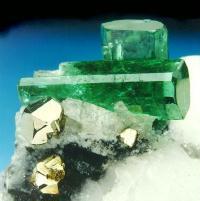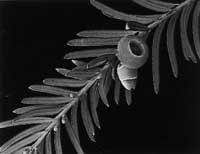Isotopes and emeralds, witnesses of the old commercial routes
2000/02/01 Roa Zubia, Guillermo - Elhuyar Zientzia

Since the time of the ancient Egyptians, emeralds have been jewels of great importance. They became a symbol of immortality and power. It is a green jewel belonging to the group of the berilos. A. C. By 1500, in the mines of Cleopatra the servants were forced to work in search of emeralds. The Egyptian pharaohs then began to expand the Emerald market. The Romans, when they dominated the trade of the Mediterranean Sea, united emeralds with jewelry. XVI. In the eighteenth century the conquerors began to exploit the mines of South America.
Location unknown
However, most of these precious stones that have been famous over the centuries are not known today. But a group of French researchers decided to apply the measurements of the isotope 18 of oxygen to solve the mystery of the origin of the emeralds. Experiments since Roman times XVIII. They have been produced with nine emeralds collected until the twentieth century and the results have been published in the last issue of the specialized journal Science.
Isotopes 18 and 16 of oxygen are stable and their proportion is known in the emeralds of each origin. Therefore, by measuring the proportion that any sample has, you can know where it is from, that is, they have a “domestic signal” recorded in their structure. Nancy researchers, led by Gaston Giuliani, know much of these signs and decide to find out the origin of some emeralds. More than a remarkable result, it is surprising.
The oldest emerald studied is that of a Roman ear-gaul discovered in Miribel. So far we knew that the emeralds came out of the mines of Egypt and Austria. The latter were discovered by the Celtic peoples, but were exploited by the Romans. After twice measuring the proportion of oxygen isotopes, the scientists saw that the value obtained only has the emeralds found in the Swat-Mingora district of Pakistan. Therefore, this emerald was collected in the valleys of Swat and Peshawar. The result is coherent because in those times commercial roads were opening away. In fact, the Silk Road was heading from these valleys to Afghanistan, a natural passage from Pakistan. The most surprising thing is that these mines are officially XX. They were discovered in the 19th century.
Brought from America
Another interesting emeralds that have been analyzed is the one found in the galleon Nuestra Señora de Atotxa. The ship sank off the coast of Florida. No emerald was specified in the vessel transport inventory. However, oxygen isotopes clearly indicated the origin of the gem. It was collected in the Colombian area of Muzo, specifically in the Tequendama Mine. In addition, the morphology of this rock is the same as that of others found in the medianera.
The results of the research suggest another surprising fact. The precious stones collected in Colombia were sold and bought in Europe and the Middle East and India. and XVIII. for centuries. On the other hand, although the official description dates back to this century, in those times some of the mines of Pakistan and Afghanistan were known. Stones, therefore, have much to tell and teach about history. The point is that we need to guess how to read.

Gai honi buruzko eduki gehiago
Elhuyarrek garatutako teknologia





